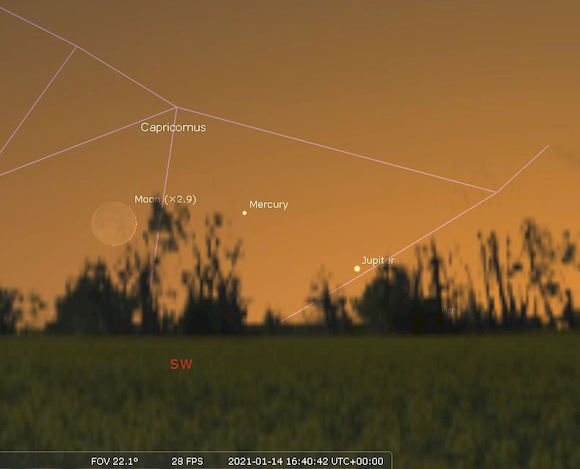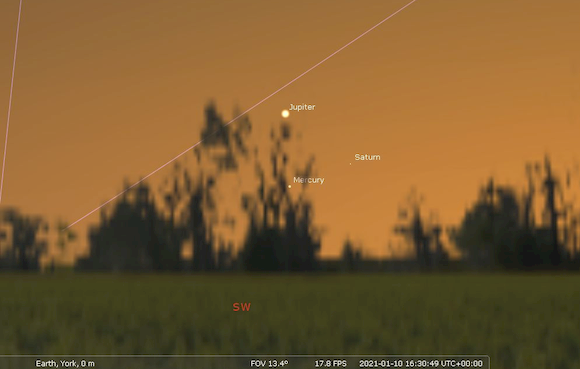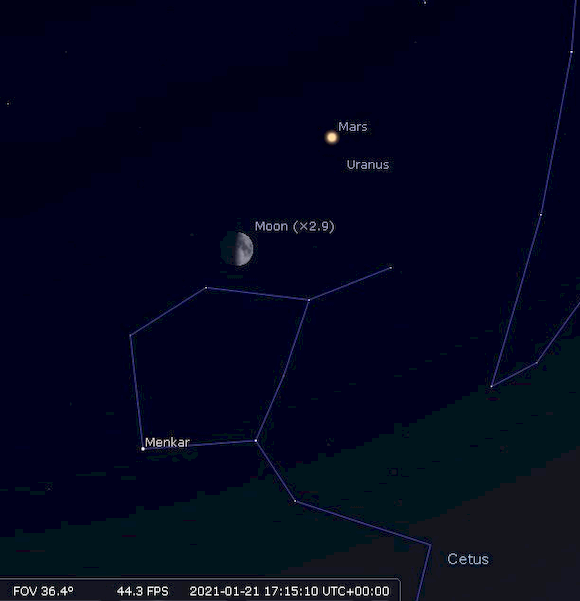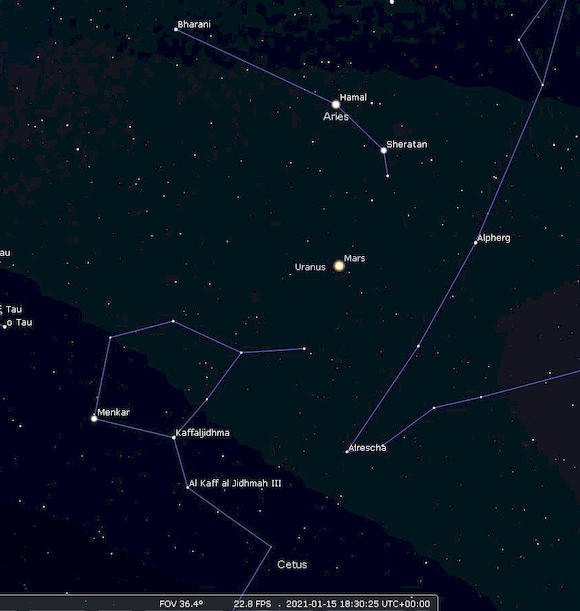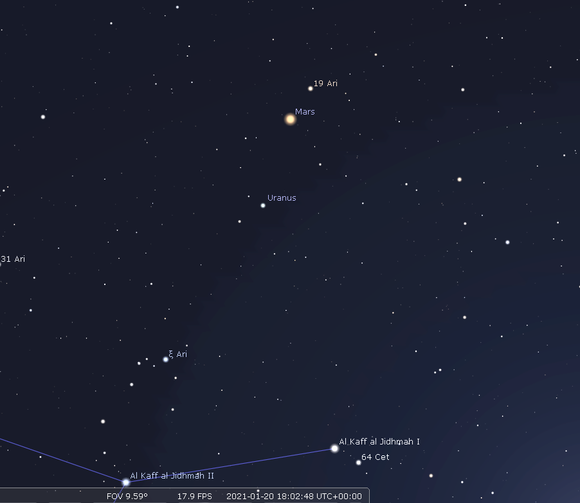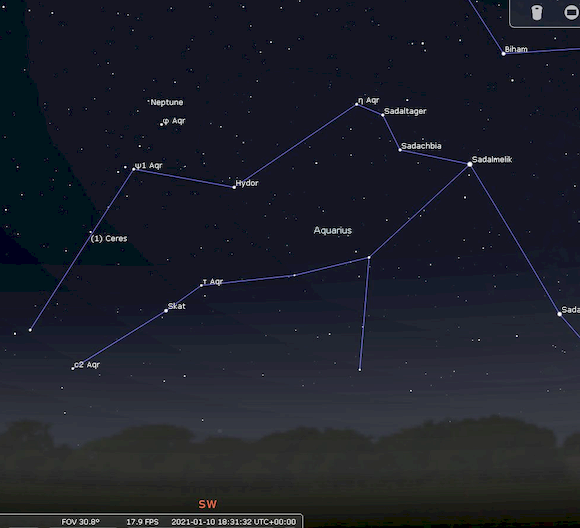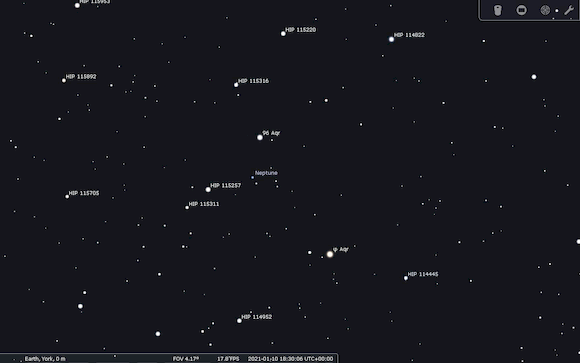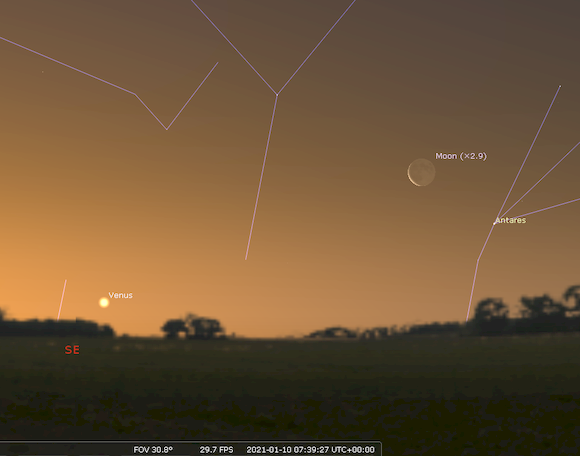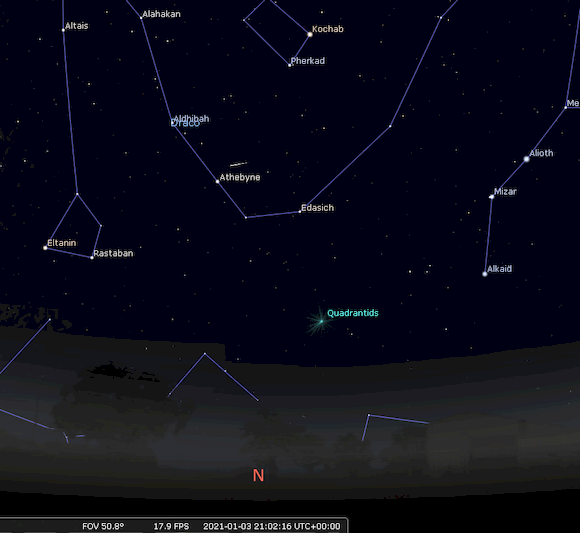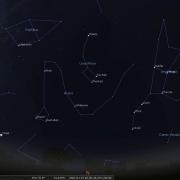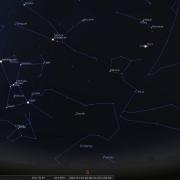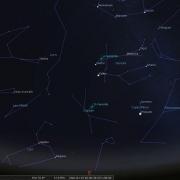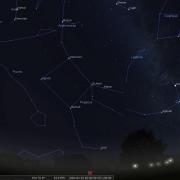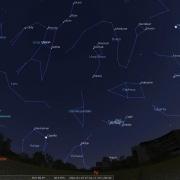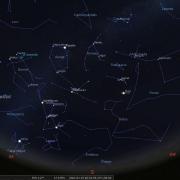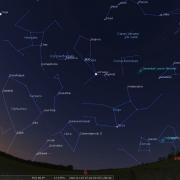In this month's Sky Notes:
Planetary Skylights - Brief
Jupiter and Saturn are joined by Mercury very low in the SW evening twilight sky. This trio of planets soon becomes a duo, as first Saturn departs and then shortly after mid month, Jupiter finally succumbs, leaving just elusive Mercury for the remainder of the month. Venus also departs in January, finally dropping out of sight in the dawn sky. Mars is the sole naked eye planet readily visible in the night sky.
 For the first couple of weeks of the New Year, Jupiter may still be viewed in the early evening sky, barely five degrees above the SW horizon as twilight falls 30 - 45 minutes after sunset. At magnitude -1.9 Jupiter will still appear conspicuous to the naked eye, it will certainly be the brightest of the three planets visible in this direction. You will however require a clear unobstructed SW horizon to spot them with Jupiter lingering around 90 minutes after sunset before setting. This dwindles to almost nothing shortly after midmonth, after which the King of the planets will be lost for over a month, reappearing in the late February dawn sky.
For the first couple of weeks of the New Year, Jupiter may still be viewed in the early evening sky, barely five degrees above the SW horizon as twilight falls 30 - 45 minutes after sunset. At magnitude -1.9 Jupiter will still appear conspicuous to the naked eye, it will certainly be the brightest of the three planets visible in this direction. You will however require a clear unobstructed SW horizon to spot them with Jupiter lingering around 90 minutes after sunset before setting. This dwindles to almost nothing shortly after midmonth, after which the King of the planets will be lost for over a month, reappearing in the late February dawn sky.
 Mercury has switched allegiance once again, swapping the dawn chorus of late November for the January evening commute. Look for it from the 10th onwards below Jupiter, creeping up from the SW horizon, passing to the left of Jupiter over several days. Although this particular apparition may not be Mercury's finest in 2021, reaching just 7 degrees in altitude above the horizon when at its brightest, at magnitude -0.9 Mercury will be reasonably conspicuous to the naked eye, especially early in the apparition. Mercury lingers in the evening twilight for the remainder of January reaching greatest eastern elongation from the Sun on Jan 24th when it is 13 degrees above the horizon. By then it has faded to -0.5 magnitude and continues to do so as it drops back toward the SW horizon. Observe if you can during the middle third of January, using binoculars to pick Mercury out of the twilight should it prove elusive to the naked eye. Always view 30-50mins after sunset.
Mercury has switched allegiance once again, swapping the dawn chorus of late November for the January evening commute. Look for it from the 10th onwards below Jupiter, creeping up from the SW horizon, passing to the left of Jupiter over several days. Although this particular apparition may not be Mercury's finest in 2021, reaching just 7 degrees in altitude above the horizon when at its brightest, at magnitude -0.9 Mercury will be reasonably conspicuous to the naked eye, especially early in the apparition. Mercury lingers in the evening twilight for the remainder of January reaching greatest eastern elongation from the Sun on Jan 24th when it is 13 degrees above the horizon. By then it has faded to -0.5 magnitude and continues to do so as it drops back toward the SW horizon. Observe if you can during the middle third of January, using binoculars to pick Mercury out of the twilight should it prove elusive to the naked eye. Always view 30-50mins after sunset.
 Saturn will be more of a challenge to spot in the evening twilight in early January, less than five degrees above the SW horizon and fainter than both Jupiter and Mercury. After last month's extremely close conjunction with Jupiter, the separation has increased as Jupiter moves away upper left of Saturn. On the 10th it forms a triangle with Mercury (below left) and Jupiter (upper left). By the 14th you will struggle to see it at all. Like Jupiter, it will return in the dawn sky later in February.
Saturn will be more of a challenge to spot in the evening twilight in early January, less than five degrees above the SW horizon and fainter than both Jupiter and Mercury. After last month's extremely close conjunction with Jupiter, the separation has increased as Jupiter moves away upper left of Saturn. On the 10th it forms a triangle with Mercury (below left) and Jupiter (upper left). By the 14th you will struggle to see it at all. Like Jupiter, it will return in the dawn sky later in February.
 Mars is now rapidly diminishing in brightness, fading from magnitude -0.2 at the start of the new year, to just +0.4 by the end of January, by which time it appears just 8 arc seconds in diameter. Having said that, Mars will still appear relatively conspicuous to the naked eye, but well beyond it's prime through the eyepiece of a telescope. The red planet lies in southern Aries, located midway up in the south during the evening, its distinct orange/red hue giving it away. Mars is slowly moving in the direction of Aldebaran, marking the 'fiery eye' of the bull - Taurus. By the end of January Mars will be setting not long after midnight. The moon lies below Mars on the 21st, when Mars is also in conjunction with Uranus. (see Uranus)
Mars is now rapidly diminishing in brightness, fading from magnitude -0.2 at the start of the new year, to just +0.4 by the end of January, by which time it appears just 8 arc seconds in diameter. Having said that, Mars will still appear relatively conspicuous to the naked eye, but well beyond it's prime through the eyepiece of a telescope. The red planet lies in southern Aries, located midway up in the south during the evening, its distinct orange/red hue giving it away. Mars is slowly moving in the direction of Aldebaran, marking the 'fiery eye' of the bull - Taurus. By the end of January Mars will be setting not long after midnight. The moon lies below Mars on the 21st, when Mars is also in conjunction with Uranus. (see Uranus)
 Uranus is now well placed to track down in the evening sky, residing just within the borders of Aries, approximately 10 degrees below the ‘crooked line’ asterism of the Ram marked by the stars Hamal, Sheratan and Mesatim. Even more conveniently Mars pays Uranus a visit during January, being within four degrees of Uranus (a typical 7x50 binocular field of view) from mid-month onwards. The two planets are in conjunction on the 20th, when Uranus resides just one and a half degrees lower left of Mars, and is almost as close the following evening. You will locate them due south at 1800hrs. At mag +5.8 Uranus is borderline naked eye for keen sighted observers viewing from dark viewing locations (assuming they know exactly where to look). Through binoculars Uranus resembles a rather faint star, off-white in hue. You will require a telescope (80mm upwards) to discern its tiny disk, which appears slightly ghoulish green in lustre.
Uranus is now well placed to track down in the evening sky, residing just within the borders of Aries, approximately 10 degrees below the ‘crooked line’ asterism of the Ram marked by the stars Hamal, Sheratan and Mesatim. Even more conveniently Mars pays Uranus a visit during January, being within four degrees of Uranus (a typical 7x50 binocular field of view) from mid-month onwards. The two planets are in conjunction on the 20th, when Uranus resides just one and a half degrees lower left of Mars, and is almost as close the following evening. You will locate them due south at 1800hrs. At mag +5.8 Uranus is borderline naked eye for keen sighted observers viewing from dark viewing locations (assuming they know exactly where to look). Through binoculars Uranus resembles a rather faint star, off-white in hue. You will require a telescope (80mm upwards) to discern its tiny disk, which appears slightly ghoulish green in lustre.
 Neptune resides in the constellation of Aquarius, which resides due southwest around mid-month at 1800hrs. It is slowly slipping down toward the SSW horizon and by the end of January will be lost shortly after1900hrs. You can locate Neptune one degree twenty arc minutes north-east of the star Phi aqr (mag +4.2), whilst 96 aqr. (mag+5.5) lies 25 arc minutes to the WNW of it. You will certainly require a telescope to spot the diminutive disk, which is just 2 arc degrees in size and has a blue/grey hue. Binoculars will only show it as a speck; if you know exactly where to look. The moon lies off to the left on the 17th.
Neptune resides in the constellation of Aquarius, which resides due southwest around mid-month at 1800hrs. It is slowly slipping down toward the SSW horizon and by the end of January will be lost shortly after1900hrs. You can locate Neptune one degree twenty arc minutes north-east of the star Phi aqr (mag +4.2), whilst 96 aqr. (mag+5.5) lies 25 arc minutes to the WNW of it. You will certainly require a telescope to spot the diminutive disk, which is just 2 arc degrees in size and has a blue/grey hue. Binoculars will only show it as a speck; if you know exactly where to look. The moon lies off to the left on the 17th.Dawn Planets
 Venus will be challenging to spot in the dawn sky during the early part of January, hugging the SE horizon before finally slipping below the horizon. At least 'dawn' is late in the early part of January and if you have a clear unobstructed view of the SE horizon, you have a good chance of spotting Venus around 07:40am as it is still very bright. Try on the 10th when a waning crescent moon resides off to the right, upper left of the 1st mag star Antares in Scorpius.
Venus will be challenging to spot in the dawn sky during the early part of January, hugging the SE horizon before finally slipping below the horizon. At least 'dawn' is late in the early part of January and if you have a clear unobstructed view of the SE horizon, you have a good chance of spotting Venus around 07:40am as it is still very bright. Try on the 10th when a waning crescent moon resides off to the right, upper left of the 1st mag star Antares in Scorpius.
 Finally, on Jan 3rd Earth reaches Perihelion (closest to the Sun in its orbit) some 91.4 million miles or 147 million km distant. This always comes as a surprise to non-astronomers; It’s not the distance from the Sun which dictates the temperature and gives rise to colder winter days, but the tilt of the Earth’s axis, in our case in the northern hemisphere, away from the Sun. It will be July when our planet reaches aphelion-furthest from the Sun in its orbit. Hope we'll be able to make full use of the warmer days then!
Finally, on Jan 3rd Earth reaches Perihelion (closest to the Sun in its orbit) some 91.4 million miles or 147 million km distant. This always comes as a surprise to non-astronomers; It’s not the distance from the Sun which dictates the temperature and gives rise to colder winter days, but the tilt of the Earth’s axis, in our case in the northern hemisphere, away from the Sun. It will be July when our planet reaches aphelion-furthest from the Sun in its orbit. Hope we'll be able to make full use of the warmer days then!
Meteors- The Quadrantids

After a good show of Geminid meteors around peak night last month (some were spotted from our area in the wee small hours of the 14th - after skies cleared somewhat), the New year starts with one of the more prolific meteor showers, the Quadrantids, active between Jan 1- 6th The shower’s short lived peak normally falls late on the 3rd or early hours of the 4th, around 2- 4am. This, along with often unsettled weather is the main reason the shower is poorly observed. In favourable observing conditions zenith hourly rates (ZHR) can exceed 100, usually in the early morning hours. This year the shower’s short lived peak falls during the afternoon of the 3rd, therefore the better chance of spotting some shooting stars will be that evening, before moonrise around 9pm. After that observed rates will be suppressed from peak numbers due to quite strong moonlight from a waning gibbous moon. Pre-moonrise, perhaps 10-20 meteors per hour will be a more realistic observed rate, as the shower radiant will be low to the north. Similar rates may be witnessed into the early morning hours, when the radiant is much higher in the NE sky, although only brighter examples will be visible, the rest drowned out.
The Quadrantids appear to radiate from the now defunct constellation of Quadrans Muralis, which was removed from sky charts in 1922, but used to lie at the junction between Hercules, Bootes and Ursa Major. This position in the sky is located low to the N at the time of the peak, so do not concentrate on this aspect, but instead 40-60 degrees (3 hand spans) either side and mid way up in the sky. Of course the great thing about meteor showers is that you do not require any additional optical assistance, just your eyes, so wrap up warmly and good hunting.
January 2021 Sky Charts
Additional Image Credits:
- Planets and Comets where not otherwise mentioned: NASA
- Sky Charts: Stellarium Software
- Log in to post comments

